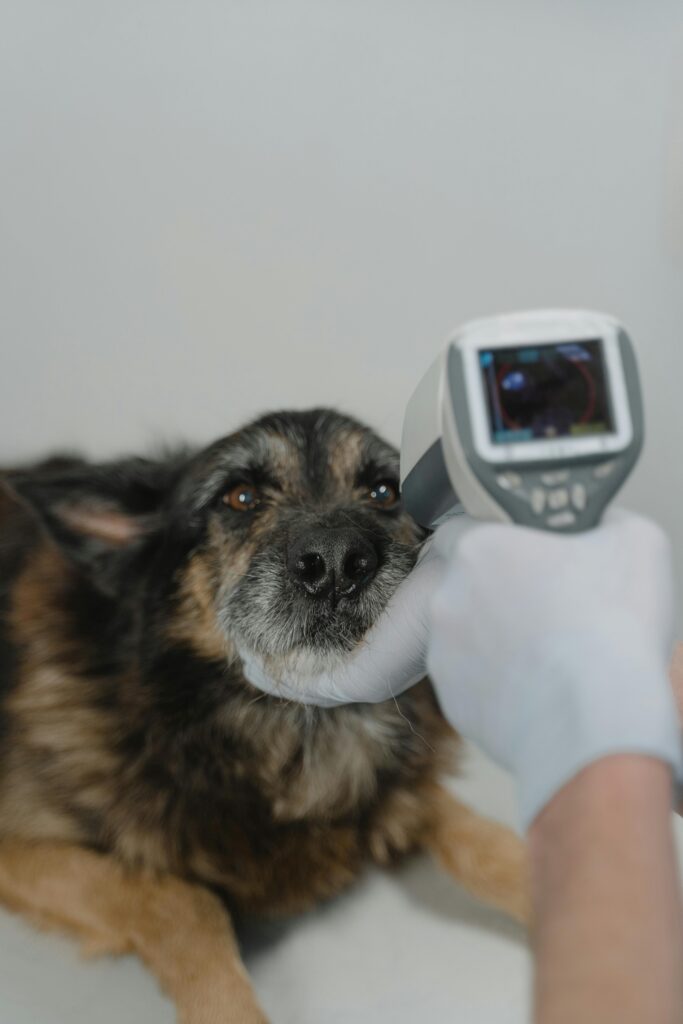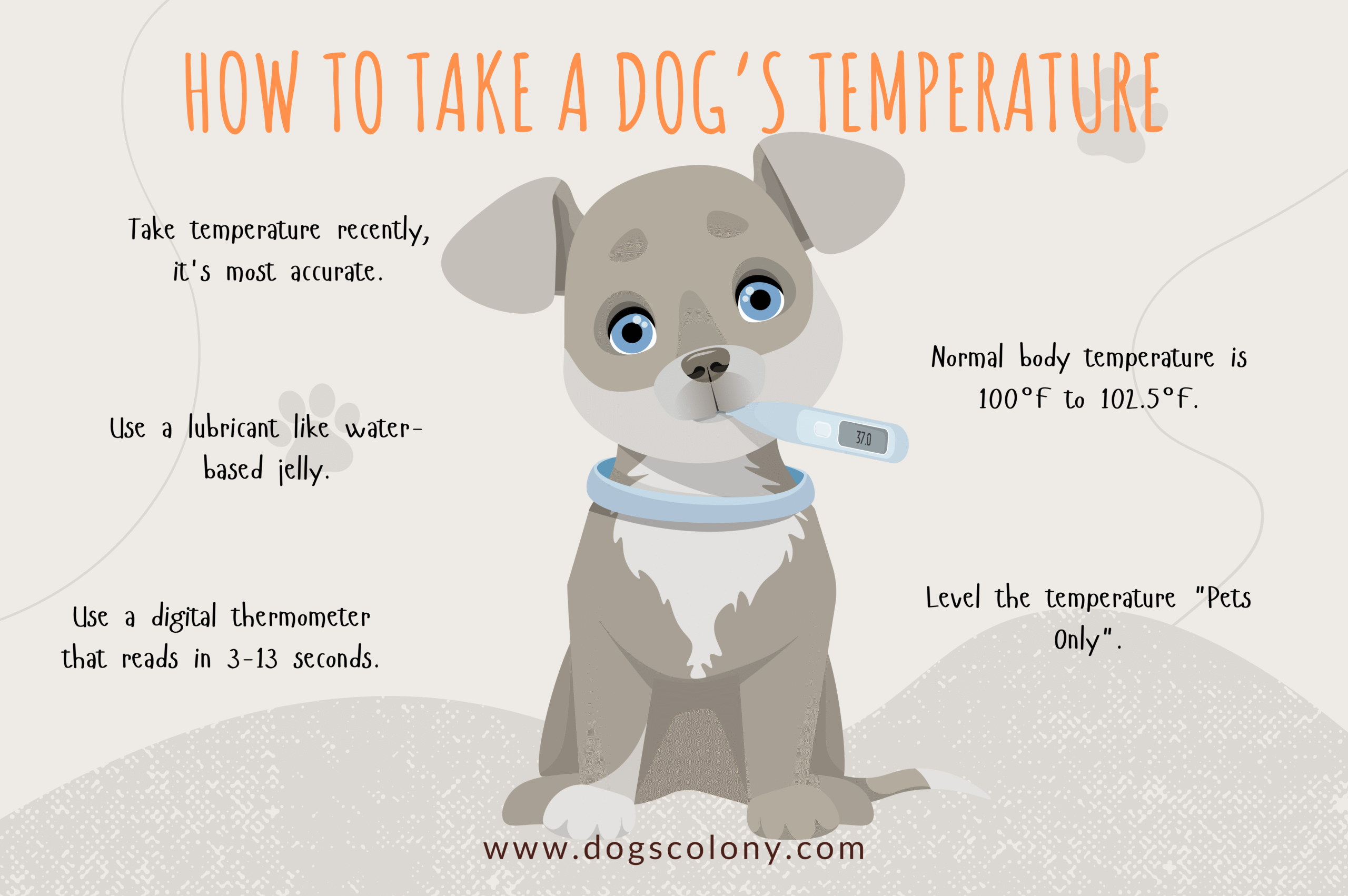- Understanding the Importance of Your Dog’s Body Temperature
- What Is a Normal Temperature for Dogs?
- Symptoms That Indicate a Temperature Check Is Needed
- Tools You’ll Need to Measure Your Dog’s Temperature
- Methods to Check a Dog's Temperature Safely
- When to Call the Vet
- Tips for Taking Your Dog’s Temperature Without Stress
- How Often Should You Check Your Dog’s Temperature?
- Home Remedies and First Aid for Abnormal Temperature
- Mistakes to Avoid When Taking Your Dog’s Temperature
- Using Temperature Checks as Part of a Holistic Health Routine
- Conclusion
- FAQs
Dog temperature problems are a common issue in our puppy’s life. Dogs can’t tell us when they’re feeling hot, cold, or feverish—so it’s up to us as pet parents to be vigilant and proactive. One key way to do that is by understanding how to check your dog’s body temperature. It may sound technical, even intimidating, but it’s a crucial skill that every responsible dog owner should learn. Why? Because your dog’s temperature can tell you a lot about their health and can even alert you to serious issues like infection, heatstroke, or hypothermia before they escalate.
So, how do you check a dog’s temperature safely? What tools do you need? What’s considered normal? This guide will break it all down for you—step-by-step, in simple language, and with clear instructions. Whether you’re a new pet parent or a seasoned dog lover, this article will give you the confidence to monitor your furry friend’s temperature like a pro.
Let’s dive right into everything you need to know about checking your dog’s body temperature.
Understanding the Importance of Your Dog’s Body Temperature
Why Monitoring Temperature Matters
Your dog’s temperature is one of the most reliable indicators of their internal health. Just like with humans, when a dog’s body temperature goes above or below the normal range, it’s a sign that something is off. Elevated temperature might point to infections, inflammations, or heatstroke, while a low temperature could indicate shock, exposure to cold, or metabolic problems.
Monitoring your dog’s body temperature isn’t just about spotting problems—it’s also about acting early. Catching a fever in time can mean the difference between a manageable illness and a trip to the emergency vet. Dogs are experts at hiding discomfort, and by the time you notice physical symptoms, the condition may already be serious.
Routine temperature checks are also vital for senior dogs, puppies, and dogs recovering from surgery. These groups are more vulnerable to temperature fluctuations, and keeping an eye on their vitals can prevent complications. If your dog has been acting strange—lethargic, shivering, panting excessively—it’s worth grabbing a thermometer and getting a reading.
Think of body temperature as a “check engine” light. You wouldn’t ignore that light in your car, right? The same should go for your dog. Knowing when to check, how to interpret the results, and what actions to take could help you prevent emergencies and ensure a long, healthy life for your pup.
Common Signs of Temperature Irregularities
So, how do you know your dog’s temperature might be off? Luckily, there are several telltale signs that signal it’s time to investigate. For high temperatures (fever), you might notice:
- Warm ears or nose
- Shivering despite being in a warm environment
- Red or glassy eyes
- Lethargy and weakness
- Loss of appetite
- Vomiting or diarrhea
- Rapid heart rate
On the flip side, symptoms of a low body temperature (hypothermia) can include:
- Shivering and trembling
- Pale or bluish gums
- Cold extremities (ears, paws, tail)
- Slow breathing
- Clumsiness or confusion
- Weak pulse
These signs don’t always mean there’s a medical emergency, but they do warrant closer inspection. If you’re seeing a combination of these symptoms, grab your thermometer. A single reading can help you decide whether your dog needs rest, warmth, or an urgent vet visit.
Being aware of these indicators puts you in control. You don’t need to wait for drastic symptoms before you act—just stay alert and proactive.
What Is a Normal Temperature for Dogs?
Healthy Temperature Range for Dogs
A dog’s normal body temperature is slightly higher than a human’s. While we humans average around 98.6°F (37°C), our furry friends sit comfortably between 101°F and 102.5°F (38.3°C to 39.2°C). Anything below or above this range could indicate a problem, depending on the circumstances.
A temperature above 103°F is considered a fever in dogs, and a temperature above 106°F can be life-threatening. On the lower end, anything under 99°F suggests hypothermia, which also requires immediate attention.
Understanding what’s normal for your particular dog is key. A small fluctuation doesn’t always mean disaster—it could be due to excitement, physical activity, or even a warm day. But consistently high or low readings? That’s your cue to investigate.
Keeping a temperature log is a great way to spot trends and anomalies. If your dog’s temperature reads a little higher after a walk on a summer day, and it returns to normal quickly, that’s likely fine. But if you’re seeing persistently high numbers paired with strange behavior, it’s time to call your vet.
Differences Based on Breed and Age
Believe it or not, normal temperature can vary slightly based on your dog’s breed, age, and even size. Puppies often run a bit warmer than adults—sometimes up to 102.5°F—because their thermoregulatory systems are still developing. On the other hand, senior dogs may have slightly lower temperatures or may not show fever signs as clearly as younger dogs.
Breed can also play a role. For example, brachycephalic breeds like Bulldogs or Pugs are more prone to overheating due to their short nasal passages. Meanwhile, hairless or thin-coated breeds may lose body heat faster, putting them at risk for hypothermia in colder weather.
Body size is another factor. Smaller dogs lose body heat more rapidly than larger ones, so they might experience temperature swings faster. Understanding these nuances helps you tailor your care and makes your temperature readings more accurate and relevant.
Always factor in your dog’s unique profile when assessing their temperature. What’s “normal” isn’t one-size-fits-all, and knowing your dog’s baseline will help you act fast if something feels off.
Symptoms That Indicate a Temperature Check Is Needed
Signs of Fever in Dogs
Fever in dogs can be subtle at first, but knowing the signs can make a huge difference. Unlike humans, dogs can’t verbalize when they’re feeling unwell, so you’ve got to rely on behavioral cues and physical changes.
Here are some common signs your dog may have a fever:
- Warm ears or a hot nose: While this isn’t a diagnostic method, it’s often an early warning sign.
- Lethargy and decreased activity: If your normally active pup is suddenly lazy or uninterested in playing, take note.
- Loss of appetite: Refusing meals is a red flag.
- Shivering or trembling: Dogs may shake due to the internal chills caused by a rising fever.
- Coughing, sneezing, or nasal discharge: These could point to a respiratory infection.
- Red eyes or cloudy discharge: Often linked to systemic infections.
The moment you notice two or more of these symptoms, check your dog’s temperature using a reliable method (we’ll get to that soon). A temperature reading over 103°F confirms a fever. Anything over 106°F should be treated as a veterinary emergency, as it can cause organ failure or even death.
Don’t ignore the signs—your dog’s life could depend on it.
Signs of Hypothermia in Dogs
Hypothermia is just as serious as fever, especially in cold climates or with certain vulnerable dogs. Puppies, senior dogs, and toy breeds are especially at risk. Recognizing the early signs can prevent critical outcomes.
Symptoms of hypothermia include:
- Violent shivering or trembling
- Limp or lethargic behavior
- Cold ears, paws, and tail
- Pale or blue-tinged gums
- Disorientation or confusion
- Slow breathing and heart rate
If your dog’s body temperature dips below 99°F, it’s considered hypothermic. Mild hypothermia can often be reversed at home with blankets, warm (not hot) compresses, and a safe indoor environment. But moderate to severe hypothermia needs veterinary attention right away.
Hypothermia can sneak up on a dog during long walks in freezing temperatures or after a bath if they’re not dried properly. Always monitor your dog closely during cold exposure, especially if they’re not bred for harsh climates.
Tools You’ll Need to Measure Your Dog’s Temperature
Types of Thermometers You Can Use
Let’s talk tools. Not all thermometers are created equal when it comes to dogs. Here are the main types used for taking a dog’s temperature:
- Digital Rectal Thermometer – The gold standard. It gives accurate readings and is relatively fast.
- Infrared Ear Thermometer – Easier to use, especially for squirmy dogs, but slightly less accurate.
- Non-Contact Infrared Thermometer – Very convenient but not reliable for internal temperature. Best used as a secondary option.
- Mercury Thermometers – Old school, fragile, and slow. Not recommended due to the risk of breakage.
Most vets recommend digital rectal thermometers because they offer the best balance of accuracy and speed. If you’re serious about monitoring your dog’s health at home, investing in one is a smart move.
Choosing the Right Thermometer for Your Dog
So, which one should you choose? Here’s a quick breakdown:
- For accuracy and reliability: Go with a digital rectal thermometer.
- For ease of use and speed: Try an infrared ear thermometer, especially for large breeds or anxious dogs.
- For basic checks or travel: Keep a non-contact thermometer as a backup, but don’t rely on it for medical decisions.
Look for thermometers specifically labeled for pet use. These are designed for your dog’s anatomy and behavior, and they’ll typically come with flexible tips and fast read times.
Also, always keep lubricant (like petroleum jelly) and disposable gloves on hand for a smooth, hygienic process.
Methods to Check a Dog’s Temperature Safely
Rectal Temperature Method
If you’re aiming for precision, the rectal method is your go-to technique. While it might not be the most glamorous task in pet care, it’s undoubtedly the most accurate way to measure your dog’s internal body temperature. Here’s how to do it safely and with as little stress for your dog (and you) as possible.
First, gather your supplies: a digital rectal thermometer, petroleum jelly (or any safe lubricant), and a helper if your dog tends to squirm. Make sure the thermometer is clean and ready. Have some treats nearby to reward your pup afterward, because they’re going to deserve it.
Start by having your dog either stand or lie on their side, whichever position they’re most comfortable in. Ask your helper to gently hold your dog still. Lift the tail and insert the thermometer slowly into the rectum—about one inch for small dogs, and up to two inches for larger breeds. Go slow and steady to avoid causing discomfort.
Wait for the beep (most digital thermometers take 10–60 seconds), then gently remove the thermometer and read the result. Clean the thermometer thoroughly after each use, and don’t forget to praise and treat your dog. This positive reinforcement helps make future temperature checks easier.
If your dog is highly anxious or aggressive about handling, don’t force it. It’s okay to seek veterinary help if the process becomes too stressful for either of you.
While it’s not the most pleasant part of pet care, learning to use the rectal thermometer is a vital skill that can help you act quickly in emergencies. And once you’ve done it a couple of times, it becomes a routine part of your at-home health checks.
Ear (Auricular) Temperature Method
For pet parents looking for a more comfortable and less invasive option, the ear method—also known as the auricular method—is worth considering. It’s quicker and more pleasant for most dogs, although it does come with a trade-off: slightly less accuracy than the rectal method.
Ear thermometers for dogs are specially designed to measure the infrared heat waves emitted from the eardrum. Because this part of the ear shares a blood supply with the hypothalamus (the brain’s temperature regulator), it offers a relatively close approximation of core body temperature.
Here’s how to do it properly: First, make sure your dog is calm. Gently lift their ear and insert the thermometer into the ear canal. You’ll want to aim horizontally—toward the opposite eye, rather than down. Most ear thermometers will give you a reading in just a few seconds.
If your dog has a lot of earwax, a recent ear infection, or inflammation, this can interfere with accuracy. Make sure the ears are clean and healthy before using this method. If your dog has long or floppy ears, gently lift and hold the ear flap up and out of the way to ensure a straight path to the eardrum.
While not as precise as rectal thermometers, ear thermometers are a fantastic option for regular monitoring, especially in dogs that won’t tolerate rectal checks. Just remember: if something seems off or you get an unusually high or low reading, confirm with a rectal temperature or consult your vet.
When to Call the Vet
Recognizing Emergency Temperature Readings
Now that you know how to measure your dog’s temperature, it’s crucial to understand what readings are red flags. Sure, a mild fever may resolve on its own, but some readings demand immediate medical attention.
If your dog’s temperature exceeds 103.5°F, you’re stepping into dangerous territory. At 105°F, the risk of heatstroke and organ damage becomes very real. And temperatures above 106°F are considered a veterinary emergency—this level of hyperthermia can quickly lead to irreversible complications or even death.
On the flip side, if your dog’s temperature drops below 99°F, they could be experiencing hypothermia. At 95°F or lower, it becomes critical. In such cases, your dog’s internal systems start shutting down, which requires urgent care and potentially life-saving intervention.
Don’t wait and see. If your thermometer shows readings this extreme, call your vet or head to the nearest emergency clinic. Let them know the exact reading and describe any other symptoms your dog is showing—this helps the veterinary team prepare the right treatment as soon as you arrive.
Also, trust your instincts. If your dog is acting oddly, panting heavily, collapsing, or unresponsive, don’t rely on the thermometer alone. Clinical signs are just as important as the numbers on the screen. When in doubt, make the call.
Chronic Conditions That Require Monitoring
Certain chronic health conditions in dogs make temperature monitoring more than just a reactive measure—it becomes a regular part of their care routine. If your dog has any of the following, you’ll want to keep a close eye on their temperature:
- Autoimmune diseases Can cause periodic fevers or inflammation spikes.
- Infectious diseases – Dogs recovering from parvo, distemper, or tick-borne illnesses need close temperature tracking.
- Cancer – Treatments like chemotherapy can lower immune defenses, making fever a common side effect.
- Diabetes – Complications like diabetic ketoacidosis can cause temperature changes.
- Post-operative recovery – After surgery, infection is a constant risk, and monitoring temperature helps catch it early.
In these cases, your vet may recommend that you log your dog’s temperature daily or several times a week. Keeping a health journal can be incredibly helpful for ongoing treatment. Include the date, time, temperature, and any observed symptoms—this creates a clear picture for your vet and can lead to better, faster decisions during checkups or emergencies.
Being proactive with chronic conditions can prevent relapses and improve your dog’s quality of life. Don’t just rely on outward signs—those can come too late. Make temperature checks a habit.
Tips for Taking Your Dog’s Temperature Without Stress
Training Your Dog to Tolerate the Process
Let’s be real—no dog is naturally excited about getting a thermometer inserted anywhere. But with some patience and positive reinforcement, you can train your pup to accept it calmly and even willingly. The key is consistency, treats, and lots of praise.
Start with desensitization. Let your dog sniff the thermometer while you reward them with treats. Touch their tail gently, lift it briefly, and treat again. Do this a few times without actually inserting anything. You’re building trust and teaching them that nothing bad happens during the process.
Gradually introduce the thermometer. Touch it to the outside of the rectum, and immediately reward your dog. After a few sessions, you can try inserting it slightly, again followed by praise and treats. Use a calm, gentle voice and avoid sudden movements.
The same goes for ear thermometers. Gently handle your dog’s ears often, so they’re comfortable with having them touched. Then start introducing the thermometer the same way—slow, gentle, and always followed by something pleasant.
Training sessions should be short, positive, and ideally done when your dog is relaxed, not during playtime or after a stressful event. Consistency is crucial. Eventually, your dog will see thermometer time as just another routine they’re used to.
This doesn’t just make your life easier—it ensures you’re able to check their health when it really matters.
How Often Should You Check Your Dog’s Temperature?
Routine Monitoring vs. Emergency Checks
How often you should check your dog’s temperature really depends on their overall health, lifestyle, and any existing medical conditions. For most healthy dogs, you don’t need to check their temperature regularly unless you notice something’s off, like a sudden change in behavior, energy level, or appetite.
However, there are specific situations where more frequent monitoring is recommended:
- During illness or recovery: If your dog is sick or has just had surgery, check their temperature once or twice daily, as advised by your vet.
- After vaccinations: Some dogs develop mild fevers post-vaccine, so a quick check within 24–48 hours is wise.
- In extreme weather: After exposure to cold or heat, check your dog’s temperature to rule out hypothermia or heatstroke.
- In working dogs or highly active breeds: Dogs that compete, herd, or participate in strenuous activities may need post-event temperature checks to ensure they’re recovering properly.
- Chronic illness: Dogs with autoimmune diseases, cancer, or other long-term issues may require daily monitoring.
Create a consistent schedule if your dog falls into any of these categories. Ideally, check at the same time each day to maintain consistency. Keep a log of each reading along with notes on your dog’s behavior, eating habits, and any other symptoms.
For healthy dogs, reserve temperature checks for when they show signs of being unwell. Over-monitoring can cause stress, and that stress can even raise your dog’s temperature artificially. Use your judgment—and always consult your vet when in doubt.
In short, don’t obsess, but don’t ignore the signs either. Knowing when to act is key.
Home Remedies and First Aid for Abnormal Temperature

Managing Fever at Home
If your dog has a mild fever (between 103°F and 104°F) and no alarming symptoms, you might be able to treat it at home, but always call your vet first for guidance. Never try to treat a high fever yourself if your dog is lethargic, vomiting, or has a temperature above 104.5°F.
Here are a few safe things you can do for a mild fever:
- Cool down the environment: Move your dog to a cool, well-ventilated area away from direct sunlight.
- Apply cool (not cold) compresses: Place damp cloths on your dog’s paws and around their ears to help regulate their temperature.
- Offer fresh, cool water: Encourage them to drink, but don’t force it.
- Limit activity: Keep them calm and rested—physical exertion can raise body temperature further.
Do NOT give human medications like ibuprofen or acetaminophen. These are toxic to dogs and can cause severe damage, even death. The only appropriate medications are those prescribed by your vet.
Monitor their temperature every hour. If it keeps rising or doesn’t start to decline within 4–6 hours, it’s time to visit the vet.
Always err on the side of caution. A fever might seem minor, but it can be a sign of a deeper infection or illness.
Warming Up a Hypothermic Dog
Mild hypothermia (around 97°F–99°F) can often be treated at home with careful rewarming techniques. Here’s how:
- Wrap them in warm blankets or towels: Focus on core areas like the chest and abdomen.
- Use warm water bottles or heating pads: Wrap these in towels and place them near your dog, never directly on the skin.
- Move them indoors: If they were outside, bring them into a warm, draft-free area immediately.
- Offer warm (not hot) fluids: If your dog is alert, warm chicken broth or water can help hydrate and warm them from within.
For moderate to severe hypothermia (below 97°F), go to the vet immediately. Home care may not be sufficient and your dog could go into shock.
Avoid rapid rewarming, which can cause blood pressure fluctuations. Reheat gradually and monitor every 15 minutes. Hypothermia is just as life-threatening as fever, so take it seriously.
Mistakes to Avoid When Taking Your Dog’s Temperature
Even with the best intentions, it’s easy to make errors when checking your dog’s temperature. Some mistakes are minor, but others could lead to misreadings or even injure your dog. Here’s what to avoid:
- Using a human thermometer without verifying compatibility: Some digital thermometers are not suitable for dogs—always check before use.
- Inserting the thermometer too far or too shallow: This can cause discomfort or inaccurate readings. Stick to 1 inch for small dogs, 2 inches max for large breeds.
- Not lubricating the thermometer: This can hurt your dog and make them fearful of the process.
- Rushing the process: Quick movements make your dog anxious and can result in squirming, broken thermometers, or even bites.
- Ignoring sanitary practices: Always clean your thermometer before and after use with alcohol. Use gloves and wash your hands thoroughly.
- Taking your dog’s temperature right after playtime or exercise: Their temperature naturally rises with physical activity, leading to false alarms.
Make temperature checks a calm, positive, and clean process. And always double-check anything that doesn’t feel right—your instincts matter.
Using Temperature Checks as Part of a Holistic Health Routine
Your dog’s temperature is one piece of a much larger health puzzle. It shouldn’t be the only thing you monitor, but it’s a very important metric that complements everything else you observe.
Here’s how to include temperature checks in a full-body health routine:
- Combine with physical checks: Feel for lumps, look at the gums, check their coat and skin.
- Monitor eating, drinking, and bathroom habits: Changes here are often early signs of illness.
- Track weight and energy levels: Sudden drops can indicate serious issues.
- Include during grooming sessions: Use these moments to check temperature and overall condition.
- Keep a wellness journal: Note dates, temperature readings, behavior changes, and food intake. This helps both you and your vet see the big picture.
A holistic health approach gives you the best chance of catching problems early. It also deepens your bond with your dog, as you become more in tune with their rhythms and behaviors.
Temperature checks aren’t just about numbers—they’re about awareness, connection, and prevention.
Conclusion
Your dog can’t tell you when they’re burning up or freezing cold—but now, you have the tools to find out for yourself. Checking your dog’s temperature might seem intimidating at first, but with the right techniques, a little patience, and some practice, it becomes second nature.
From understanding what’s normal, spotting the warning signs, and choosing the right thermometer to safely checking and knowing when to call the vet, you’re now equipped to handle it all like a pro. More importantly, you can act quickly and confidently if something ever feels off.
Your dog counts on you for everything. Learning how to monitor their temperature is one more way you can show love, care, and responsibility. Don’t just wait for sickness to strike—be proactive, stay informed, and always trust your instincts.
You’ve got this. And your dog? They’re lucky to have you.
FAQs
1. Can I use a human thermometer on my dog?
Yes, but it needs to be a digital thermometer and ideally labeled for rectal use. Avoid oral or underarm readings as they’re not reliable for dogs.
2. How do I know if my dog has a fever without a thermometer?
Look for signs like warm ears, lethargy, shivering, and loss of appetite. However, a thermometer is the only accurate way to confirm.
3. Is it dangerous to check a dog’s temperature at home?
Not if done correctly. Use a lubricated digital rectal thermometer, handle your dog gently, and clean everything thoroughly.
4. What’s the best thermometer for dogs?
A digital rectal thermometer designed for pets is the most accurate. Ear thermometers are good alternatives for anxious dogs.
5. Can I give my dog aspirin for a fever?
No! Human medications can be toxic to dogs. Always consult your vet before giving any medication.
Please don’t forget to leave a review.




